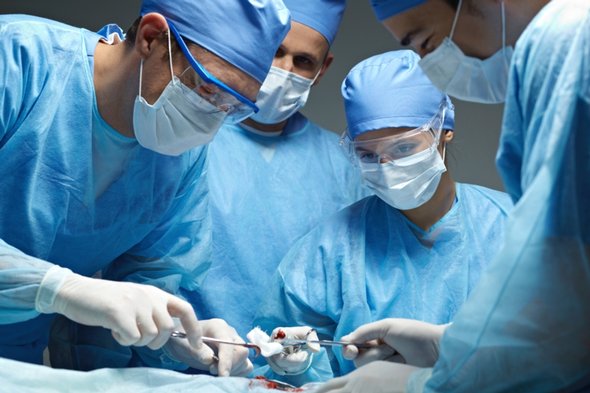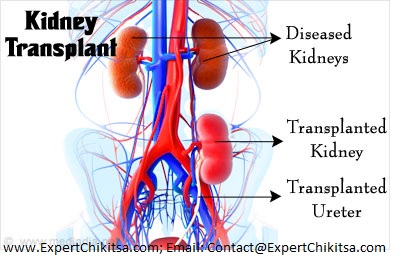What is a kidney transplant?
A kidney transplant is a surgical procedure done to implant a healthy kidney from another person. The kidney may come from a deceased donor or from a living donor.
A person receiving a transplant usually receives only one kidney, but, in rare situations, he or she may receive two kidneys. In most cases, the diseased kidneys are left in place during the transplant procedure. The transplanted kidney is implanted in the lower abdomen on the front side of the body.
Why is a kidney transplant recommended?
A kidney transplant is recommended for people who have end-stage kidney disease and will not be able to live without dialysis or a transplant. In the U.S., the most common cause of end-stage kidney disease are diabetes and high blood pressure. There are also many other causes of end-stage kidney disease. Always talk with your healthcare provider for a diagnosis.
Who are Donors for Kidney Transplantation?
All donors are carefully screened to make sure there is a suitable match and to prevent any transmissible diseases or other complications. Kidneys for transplantation come from two sources:
- Living donors: Living donors are usually immediate family members or sometimes spouses.
- Deceased/ Cadaveric donors: Deceased donor kidneys usually come from people who have willed their kidneys before their death by signing organ donor cards.
How is Kidney Transplantation Procedure done?

Kidney Transplant Surgery
- People receiving a kidney transplant are given general anesthesia before surgery. The surgeon makes a cut in the lower abdomen area.
- Surgeon places the new kidney inside the lower abdomen. The artery and vein of the new kidney are connected to the artery and vein in the pelvis. Ureter is then attached to the bladder. Patient’s own kidneys are left in place, unless they cause, high blood pressure, infections, or are too large for the body. The wound is then closed.
- Kidney transplant surgery takes about 3 hours. People with diabetes may also have a pancreas transplant done at the same time which usually adds another 3 hours to the surgery.
[box type=”info”] Please contact us for Free Medical Second Opinion, Treatment Plan, Cost Estimate, Tele-Consultation and Visa. Email: Contact@ExpertChikitsa.com Phone: +91 733 784 7661 / 7662 / 7663[/box]
What happens after a kidney transplant?
- After the surgery, you will be taken to the recovery room. Once your blood pressure, pulse, and breathing are stable and you are alert, you may be taken to the intensive care unit (ICU) for close monitoring. In time, you will be moved out of the ICU to a regular nursing unit as you recover and you are closer to going home. Kidney transplant usually calls for several days in the hospital.
- A kidney from a living donor may start to make urine right away. Urine production in a cadaver kidney may take longer. You may need to continue dialysis until urine output is normal.
- You will have a catheter in your bladder to drain your urine. The amount of urine will be measured to check how the new kidney is working.
- You will get IV fluids until you are able to eat and drink enough on your own.
- Your team will closely watch how your anti-rejection medications are working to make sure you are getting the best dose and the best combination of medications.
- Blood samples will be taken often to check the status of the new kidney, as well as other body functions, such as the liver, lungs, and blood system.
- You will slowly move from liquids to more solid foods as tolerated. Your fluids may be limited until the new kidney is working fully.
- Usually, by the day after the procedure you may start moving around. You should get out of bed and move around several times a day.
- Take a pain reliever for soreness as advised by your doctor. Avoid aspirin or certain other pain medications that may increase the chance of bleeding. Be sure to take only recommended medications.
- Nurses, pharmacists, dietitians, physical therapists, and other members of the transplant team will teach you how to take care of yourself once you are discharged from the hospital including care for your incisions.
- You will be ready to go home when your vital signs are stable, the new kidney is working, and you do not need the constant hospital care.

Kidney Transplant
What are Advantages of Kidney Transplantation?
The outcome of kidney transplants surgery continues to improve with advances in immune-suppressing medications. Following are some of the advantages;
- Freedom from dialysis and freedom from the time commitment that it requires
- Increased energyNo longer seeing themselves as chronically ill
- 3-year graft survival rate after transplantation is almost 80%.
- The earlier you can detect rejection, the better the chance it can be reversed and the new kidney’s function preserved
- Those who undergo Kidney transplant enjoy better quality of life after the procedure
- Those who receive a kidney from a living related donor do better than those who receive a kidney from a deceased donor
What is Cost of Kidney Transplantation in India?
Kidney transplant cost in India is highly competitive compared to other countries which has same facilities and expert doctors. You need to compare quality, cost and availability from multiple hospitals and them make decision.
Expert Chikitsa consultant can assist you finding right hospital for Kidney Transplant which has best Kidney Transplant Team, low cost for kidney transplant and available immediately.
Kidney Transplant Cost:
United States of America (USA) : 80,000 USD
India: 18,000 USD
Singapore: 60,000 USD
Turkey: 70,000 USD
Malaysia: 55,000 USD
[box type=”info”] Please contact us for Free Medical Second Opinion, Treatment Plan, Cost Estimate, Tele-Consultation and Visa. Email: Contact@ExpertChikitsa.com Phone: +91 733 784 7661 / 7662 / 7663[/box]
Kidney Transplant Type
Relative: In Relative Kidney Transplant donor of the kidney is relative. Relative can be 1st degree, 2nd degree or 3rd degree.
Non Relative: In non-relative Kidney Transplant donor of the kidney is not related to patient. Non relative kidney transplant is to be approved by required authorities. Expert Chikitsa Consultant will provide more details.
What Happens During Kidney Transplant
Kidney transplantation requires a stay in a hospital. Procedures may vary depending on
your condition and your physician’s practices.
Generally, a kidney transplant follows this process:
You will be asked to remove clothing and given a gown to wear.
An intravenous (IV) line will be started in your arm or hand. Additional catheters may be inserted in your neck and wrist to monitor the status of your heart and blood pressure, as well as for obtaining blood samples. Alternate sites for the additional catheters include the subclavian (under the collarbone) area and the groin.
If there is excessive hair, it may be clipped off.
A catheter will be inserted into your bladder.
You will be positioned on the operating table, lying on your back.
Kidney transplant surgery will be performed while you are asleep under general anaesthesia. A tube will be inserted through your mouth into your lungs. The tube will be attached to a ventilator that will breathe for you during the procedure.
The anaesthesiologist will continuously monitor your heart rate, blood pressure, breathing, and blood oxygen level during the surgery.
The skin over the surgical site will be cleansed with an antiseptic solution.
The physician will make a long incision into the lower abdomen on one side.
The physician will visually inspect the donor kidney prior to implanting it.
The donor kidney will be placed into the abdomen. A left donor kidney will be implanted on your right side; a right donor kidney will be implanted on your left side. This allows the ureter to be accessed easily for connection to your bladder.
The renal artery and vein of the donor kidney will be sutured (sewn) to the external iliac artery and vein.
After the artery and vein are attached, the blood flow through these vessels will be checked for bleeding at the suture lines.
The donor ureter (the tube that drains urine from the kidney) will be connected to your bladder.
The incision will be closed with stitches or surgical staples.
A drain may be placed in the incision site to reduce swelling.
A sterile bandage/dressing will be applied.
FOR MORE INFORMATION ON BEST DOCTOR & HOSPITAL, TREATMENT PLAN, COST , TELE-CONSULTATION AND SECOND OPINION CONTACT US,
Phone Numbers: +91 9620350205
Mail Id: Contact@Expertchikitsa.com
Facebook: https://www.facebook.com/ExpertChikitsa
Website: https://www.expertchikitsa.com/



